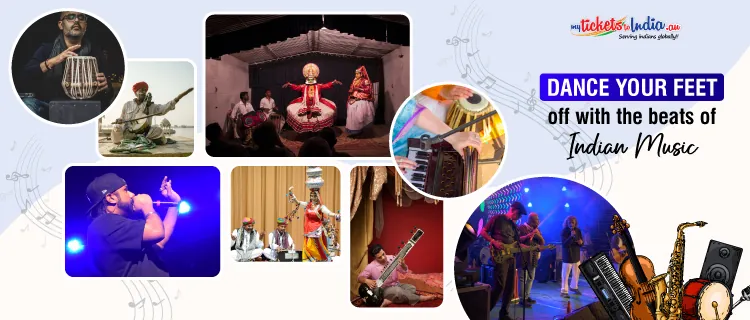Melodies and Rhythms of Indian Music: A Detailed Guide
India has a rich musical heritage that encompasses various styles of classical music, folk music, movie songs, and pop music. Indian classical music can be broadly classified into two main types: Carnatic, which originated in the South, and Hindustani, which originated in the North. Folk music is also an integral part of India’s musical tradition, known for its unique rhythms, melodies, and lyrics.
Historical Roots and Traditional Forms
Classical Indian music:
- Hindustani Classical (North India): Characterised by its complex raga (melodic frameworks) and tala (rhythmic cycles) systems, with notable instruments like the sitar, tabla, and sarod.
Tip:- If you are interested in knowing the north Indian music history consider boarding a flight from Australia To Delhi for more knowledge.
- Carnatic Classical (South India): Known for its kriti compositions and focus on vocal music. Instruments like the mridangam, veena, and kanjira play key roles.
Tip: Are you curious to know about the music history and culture of South India consider taking a flight from Australia To Hyderabad for more nourishment of your knowledge.
Folk Music:
- Growing from the diverse regional cultures of India, folk music is often performed during festivals and celebrations. Each state has its unique style — Bhangra and Giddha from Punjab, Garba from Gujarat, and Lavani from Maharashtra.
Indian Musical Instruments
- Sitar: A plucked string instrument known for its deep, rich tones, commonly used in Hindustani classical music.
- Tabla: A pair of drums, each producing distinct pitches, essential for rhythm in Indian music compositions.
- Veena: An ancient stringed instrument from South India with a rich timbre, crucial in Carnatic performances.
Indian Music and Global Influence
- Bollywood Music: Bollywood songs blend traditional Indian tunes with global music trends, creating a mix that dominates Indian pop culture.
- Fusion Music: Fusion genres combine elements from Indian and Western musical traditions, producing unique sounds that resonate globally. Artists like A.R. Rahman and Zakir Hussain are initials in this field.
Indian Meditation Music
Indian meditation music refers to a genre of music specifically crafted to facilitate meditation, relaxation, and inner peace. Typically, Indian meditation music features instruments like the sitar, tambura, and tabla, which produce calming and harmonious sounds, and on top of that Indian flute music is considered to be the best meditation music. These instruments are often played in a slow and measured manner, allowing listeners to enter a state of deep relaxation and mental clarity.
In addition to instrumental compositions, Indian meditation music may also include vocal chants, mantras, and hymns drawn from spiritual texts such as the Vedas, Upanishads, and Bhagavad Gita. Even though meditation music is not loud Indian music it can still bring about a sense of calmness and peace after listening to it.
Indian Flute Music For Yoga
Indian Flute Music For Yoga offers a peaceful and meditative backdrop for yoga practice, enhancing the mind-body connection and promoting relaxation and inner peace. The gentle melodies of the flute, combined with soothing rhythms and ambient sounds, create an atmosphere conducive to mindfulness and spiritual awareness.
Listening to Indian flute music during yoga can help calm the mind, deepen the breath, and facilitate its timeless beauty and universal appeal, Indian flute music for yoga serves as a powerful tool for enhancing the yoga experience, promoting relaxation, and deepening one’s journey of self-discovery and self-care.
Indian Rap Music
Indian rap music has emerged as a dynamic force within the country’s musical landscape, blending traditional Indian sounds with contemporary hip-hop influences to create a unique and vibrant genre. Initially gaining attraction in the underground scene, Indian rap has now entered the mainstream, captivating audiences with its bold lyrics, infectious beats, and socially conscious themes.
Moreover, Indian rap has also found its place in mainstream Bollywood cinema, with rap-infused tracks becoming a staple in film soundtracks. Bollywood films often feature rap sequences that blend traditional Indian musical elements with modern hip-hop production, further cementing rap music’s influence on popular culture.
The Spiritual and Cultural Significance of Indian Music
Music in India holds a deep spiritual and cultural significance, serving as a medium for religious expression, storytelling, and social bond.
From devotional chants to the rhythmic accompaniment of festivals and rituals, Indian music is woven into the fabric of the nation’s identity.
Best Indian Music Streaming Service
Best Indian music streaming service, as it largely depends on individual preferences, content availability, and features. However, some popular Indian music streaming platforms include:
- Gaana: Gaana offers a vast catalog of Indian music across various languages, genres, and moods. It features curated playlists, radio stations, and podcasts.
- Saavn (now JioSaavn): JioSaavn provides access to a wide range of Indian and international music, including Bollywood, regional, and indie tracks. It offers personalized recommendations and curated playlists.
- Hungama: Hungama Music offers a diverse collection of Indian and international music, along with music videos, podcasts, and live radio stations.
- Wynk Music: Wynk Music is a music streaming service by Airtel that offers a vast library of Indian and international music, including Bollywood, pop, and regional tracks. It also offers offline listening and curated playlists.
- Amazon Prime Music: Amazon Prime Music includes a selection of Indian and international music, including Bollywood, regional, and indie tracks. It’s available to Amazon Prime subscribers.
- Spotify: While not exclusively Indian, Spotify offers a growing library of Indian music across various genres and languages. It also provides personalized recommendations and curated playlists.
Each of these services has its unique features, pricing plans, and content offerings, so it’s worth exploring them to see which one best suits your preferences and needs.
Native American Indian Music
Native American Indian music contains a diverse array of traditional musical styles originating from the indigenous peoples of North America. These musical traditions vary greatly among different tribes and regions, each reflecting unique cultural practices, spiritual beliefs, and historical influences.
Traditional Native American music often features vocals, drums, rattles, flutes, and other instruments. The melodies are typically characterized by repetitive patterns, call-and-response structures, and rhythmic complexity.
In addition to traditional music, contemporary Native American musicians and artists continue to innovate and create music that blends indigenous sounds with modern genres, such as rock, jazz, and electronic music.
Tip: Book your flights from Australia to India right away if you are a music enthusiast and want to listen to Native American Indian music.
We hope you’ve liked reading this article and found it helpful. For more interesting content, keep visiting IndianVibes – it’s linked to MyTicketsToIndia, our site connecting Indians in Australia to their homeland.
Frequently Asked Questions
Q: How many ragas are there in Indian classical music?
A: Indian classical music encompasses a vast repertoire of ragas, with estimates ranging from several hundred to over a thousand distinct ragas. Ragas are melodic frameworks that form the basis of improvisation and composition in Indian classical music.
Q: What is Mr music in Indian Navy?
A: In the Indian Navy, MR stands for Matric Recruit, referring to the rank of a non-officer entry-level sailor. ‘MR Musician’ refers to sailors who are trained as musicians and serve in the Navy’s musical bands.
Q: What is Indian classical music?
A: Indian classical music is a traditional form of music originating from the Indian subcontinent. It is characterized by its elaborate melodic and rhythmic structures, improvised techniques, and rich cultural heritage.
Q: Which Indian academy is promoting dance drama and music?
A: Established by the Republic of India, the Sangeet Natak Akademi is the nation’s only academy dedicated to music, dance, and drama.
Q: What does gharana mean in Indian music?
A: In Indian music, the term ‘gharana’ refers to a particular school or tradition of performance, typically associated with a specific lineage or family of musicians.
Q: Which Veda is important for Indian music?
A: The Samaveda is particularly important for Indian music, as it contains hymns (called Samagana) that are sung in specific melodies known as Sama. These melodies are believed to be the foundation of Indian classical music.
Q: How many gharanas are there in Indian classical music?
A: There are numerous gharanas in Indian classical music,, some of the most well-known gharanas include the Gwalior, Agra, Jaipur, Kirana, Patiala, and Rampur-Sahaswan gharanas in Hindustani classical music, and the Thanjavur, Palakkad, and Mysore gharanas in Carnatic classical music.
Q: How to learn Indian classical music?
A: To learn Indian classical music: Find a skilled teacher. Learn basics like notes, melodies, and rhythms. Practice regularly. Be patient and persistent.
Q: How to dance to Indian music?
A: Listen to the rhythm, learn basic steps, and express yourself through coor

At MyTicketsToIndia, we’re all about offering great flights from Australia to India, all at the best prices. Our team works hard to give you excellent service anytime you need it. Feel free to get in touch with us whenever you want!



Many thanks for an explanation, now I will know.